The creation of a unique landscape design is the main task of land owners and cottages. For this, many gardeners are trying to find a variety of cultures that would make their garden or flower garden brighter and unusual. In recent years, high attention is paid to decorative shrubs and grassy plants that fit perfectly into any landscape design. Among the large variety of such plants is to highlight the monard - a magnificent herbaceous plant, which pleases the eye with bright and fragrant colors.
It is worth noting that the monard is not only a beautiful flowering plant, but also a fairly famous spice called Bergamot. Tea with Bergamot is an excellent completion of a hard day. Having puts the Kostik monards on his site, you will enjoy the aroma of this spice every day.
In this article, consider the features and description of the monarch, we describe its main and most popular species and varieties. We note important nuances of agrotechnics of growing monards in the open soil.
Characteristics of the Plant Monarch
Monard - a perennial or annual herb plant, which belongs to the family of licorious. This plant is essential sufficient, due to which the leaves of this culture are used as a spice of Bergamot. The monard's plant in distant times was used by the indigenous population of North America for the preparation of delicious and fragrant tea. Even earlier, this plant was used as an antipyretic agent. The natural habitat of the monarch is considered the territory of North America from Canada itself to Mexico, where this plant is found everywhere, and sometimes growing as weed. On the territory of Europe, this decorative plant came in the 16th century, when Botanic Monardez found it in Spain. It was this scientist for the first time that I described this culture for the first time, in honor of his own monard was also named. Although the scientist himself called this culture Canadian Orego. The modern name of the monard received thanks to Karl Linneu.
In the people, this plant is often referred to in different ways: American Melissa, Bergamot, lemon mint, oxod tea and others. To date, the monard flower is used as a decorative decoration of the site, as well as as a drug to strengthen the immunity or as a fragrant spice, which can be added to tea.
Description of the monard:
- The monard is a herbaceous plant that can be grown as an annual or long-term shrub.
- The monard is a branched shrub.
- A shrub can be formed with reprehensive or branched shoots, which can be in height to reach 60-100 cm.
- The stalks of the monards have a four-sided form with a slight input.
- The plant has a pretty branched root system in the form of rhizomes.
- The entire shrub is covered by oblong leaves, which are slightly gentle on the edge. The color of the foliage is dark green with a smooth or rough surface. There is a foliage contrary.
- The distinctive feature of the shrub of the monard - its foliage has a fragrant fragrance, which makes different notes depending on the variety and view: Melissa, lemon, mint.
- During flowering, the shrub is covered with small fragrant flowers that have a small shape.
- Flowers are collected in the head or blurred inflorescences, which in appearance are slightly disheveled.
- The color of the inflorescence of the monards can be purple, red, white or yellow. Rare varieties can have flowers in the speck.
- After biting at the scene of the inflorescence, the fruit appears in the form of a nuts, within which the seeds of the monards are located.
- Seeds of this plant can be stored for about three years.
- The monard is distinguished by good frost resistance, maybe without shelter to withstand frosts up to -40 degrees.
- In one place, the monard can grow 5-6 years, after which the shrub must be rejuvenated.
- Species plants can be used not only as a decorative plant, but also as a drug and fragrant spice. The hybrid monard can only be used as a decorative decoration of the site.
Diversity of species and varieties of monards
According to different estimates in the nature of the varieties of the monards, there are from 16 to 20, not all of which can be grown in garden sites. Most often in landscape design there are perennial species and varieties, however, today a large number of hybrid varieties of monards are brought by breeders. This allows you to expand the use of this plant on its plot.
Monard lemon
- This is an annual herb plant that has a distinctive feature. This is the only one-year representative who can be grown as a decorative plant, and as a fragrant spice, parts of which are used in the cooking of dishes.
- In the height, this shrub can reach 15-100 cm depending on the specific variety.
- Stems thick covered with oblong or lanceal leaves of dark green.
- The flowering of this type of monarda begins in May and lasts until July.
- Flowers with bright purple inflorescences, which consist of 5-7 mutades with a large number of small flowers.
- Flowers exude a sweet smell, which attracts insects.
- Stems, leaves and flowers of this type of monards are distinguished by essential oils, a smell resembling lemon. Due to this, all parts of the plant can be used in the preparation of dishes.
Monard pointing
- This species is distinguished by a rather unusual appearance. The shrub is covered with pinkish leaves, which are the main decoration of the species.
- Dotted yellowish color monards flowers with brown spots.
- In height, the shrub can reach 80 cm.
- In gardening, this type of plant is most often grown due to leaves, which are used in the manufacture of tea as an aromatic additive of Bergamot.
Monard twigty
- This species is a perennial herbaceous plant, the natural range of growth of which is the territory of the Great Lakes.
- In height, the plant can reach 80 cm.
- The root system is a horizontal rhizome, which is very growing.
- The monards of the monarchs are twisted.
- The stalks are completely covered with leaves that are located oppositely on short stiffs.
- Oval shape leaves with a pointed tip and toothed edge. The color of the foliage is dark green with easy-to-wear and red strips. In length, leaves can reach 12 cm.
- Little flowers are collected in a bright color inflorescences: purple, lilac, red, pink or white.
- Inflorescences in diameter reaches 6 cm.
- Shrub exudes citrus fragrance, and in the seeds contain essential oils.
Monard Tubular
- Another name of this species of the monarda is swarm.
- The natural area of \u200b\u200bhabitat of this type of monarda is the eastern part of North America.
- In Europe, these shrubs are most often grown as fragrant spices.
- This is a perennial grassy plant, which is formed by numerous reprehensive stems.
- In height, the plant can reach 60-120 cm.
- The stalks are fully covered with simple oblong leaves with a toothed edge and a small omission.
- Flowers of this plant have small lilac color, which are collected in inflorescences in the form of spherical heads.
- On one blooming can grow to 9-10 inflorescences with a diameter of 7 cm.
- This type of monarda contains essential oils that are used in medicine, perfumery and cosmetology.
- In Russia, a dwarf variety of monards of the shreddachant called Victoria was bred.
Monard hybrid
- Today, thanks to the work of breeders around the world, there are a large number of hybrid varieties.
- Such varieties are most often derived by crossing the monards of the sword and twightened.
- Data varieties are perennial plants that can be 100 cm in height.
Popular hybrid monards grades:
- Grade "Punk Croft". This plant is quite high thanks, thanks to which the flowers of this monarda can be used for cutting. The variety is distinguished by lilac-pink beautiful flowers. Monard's crough punk can grow perfectly in the shade.
- Grade "Mahagony". This variety is early, which does not prevent him from blossoming to the most frosts. It blooms this plant with bright red flowers with a slightly twisted at the ends of petals. Flowers have a pleasant fragrance.
- Sort "Scarlett". This plant in height reaches 90 cm. Flowering is rather short, the beginning of which falls for July. The colors of the bright red monards, which in diameter reach 7 cm.
- Grade "Cardinal". This plant is distinguished by bright purple inflorescences.
- Variety "Blue Stokeng". Flowers have a gentle purple-purple shade.
Monards reproduction: the most common ways
It is important to grow the monazh for each gardener, for this it is important to know the features of various breeding methods. The monard can be multiplied by a seed method, the method of drawing and dividing the bush. Learning the nuances of each of them, you can choose for yourself the most optimal.
Seed reproduction of monarchs
- This method is used extremely rare, since the plant grown from seeds lose all maternal and varietal signs. It can be used to breed species plants.
- Depending on the climate in your region, seeds can be seen immediately into open ground or use them to grow seedlings.
- In more southern territories, the seeds are seeded in an open ground in approximately in February.
- Initially, the landing place is covered with a film so that the soil has excited. Next, well loose the plot and proceed to sowing.
- Thus, seeds pass natural stratification. Shoots will appear in the spring, after which they need to be proper.
- In more northern areas, the seeds are sown around May. Before this landing material is best hardening. For this, for some time, seeds can be placed in a fridge in a wet soil.
- Prepare the soil for the monard, it is good to redo it and scatter it.
- Make furrows for sowing a depth of 2-2.5 cm and at a distance of 15-20 cm from each other.
- After that, drink the seeds of the plant and sprinkle them soil. Cover the beds with a film.
- The film is best not to remove about 3 weeks. It is allowed to lift for a short time for venting and watering.
- On the permanent place the seedlings of the monards are planted only in a year.
- In the cooler regions, the monard is grown by a seaside. For this, the seeds are sown in containers with soil. After that, crops are covered with a film and keep them so indoors with a temperature of 20 degrees.
- After 2 weeks, shoots appear. Seedlings need to be counted in separate containers in about 3 weeks after the appearance of germs.
- When three leafs appear on shootings, they can be planted in open ground.
- The seedlings planted in this way will bloom in the same year.
Reproduction of the monard dividing bush
- The division of the bush is a simpler and convenient way to reproduce the monard.
- The best time to divide the bushes of the monarda of April, when the soil hips off from ice.
- For division, bushes are used, which reached 3-4 years.
- It is necessary to neatly dig a bush from the soil, after which under running water is well rinsed the root system.
- Slightly dry the roots and gently divide the sharp knife into several parts.
- All sections are important to treat charcoal for faster healing.
- Next, prepare a place to land and land the decene, after which we bother with water.
- After 3-4 years, young decene will grow again.
The reproduction of the monard of stallowing
- In this way, we can also multiply the varietal bushes of the monards.
- The billet of cuttings is carried out before the start of flowering, for this it is used green cuttings.
- It is necessary to cut the cuttings with a length of 8-10 cm.
- Remove all lower leaves and top cuttings cut.
- Prepared cuttings can be placed in a container with a solution of the rooting agent for a while.
- Next prepare the container with the soil and fall out in it with cuttings.
- The capacity is important to cover with a dark underfloor material and place it in the dark room.
- The rooting passes by about 2-3 weeks.
- In about July or August, the cuttings can be planted for a permanent place.
Preparation before landing the monard
To obtain a beautiful and blooming decorative plant, it is important to carefully prepare before landing. Consider all the nuances of your climate, pick up high-quality planting material and find the perfect place for the monard on your site.
Stage 1. Selection of varieties and seedlings
- If you do not have the opportunity to dilute the seedlings of the monards on their own, they can be purchased in specialized garden centers or nurseries who are professionally engaged in breeding plants.
- This applies to perennial plants, for breeding annuals you can use seeds. However, for cultivation on the central part of Russia, such types of monards like a sword, twin, less often lemon and point.
- By purchasing seedlings in the nursery, you will get the opportunity to buy plants that are already adapted to your climatic conditions, which will increase the chances of good shrub acceitability.
- In the same place you can find out the features of the landing of the monards and the rules for the care.
- Before buying seedlings, carefully inspect the stalks and leaves. They should not be visible damage and fractures. There should also be no signs of diseases and pests.
- If you buy seedlings with an open root system, the roots should not be dried and damaged. Saplings in the container should grow in clean and moistened soil.
Stage 2. Choosing a place to land a monard
- The second important stage of preparation is the choice of the most suitable place to land this plant.
- The monard prefers to grow at open solar sites, where her flowers will look brighter, and the bloom itself will be more lush and abundant.
- Suitable for landing seedlings of the monard and a plot of lightweight. However, in this case, bushes may be less than the size.
- A landing place should be protected from strong winds and drafts that can bend the stems of the shrub or to break them at all.
- Before choosing the optimal place, it is necessary to take into account the dimensions of the adult Koxy of the monard, which is good enough. Therefore, for one plant, it is necessary to take about 1-1.5 m.
Stage 3. Choice and soil preparation before landing
- The monard is not distinguished by special demanding soils, but this shrub will be bad on the heavy soil.
- Choose a plot with light and nutrient soil whose acidity is low. If you have very acidic soils on your site, it is important to add some lime to it during processing.
- The soil should not be too raw, since the plant can grow badly and develop on such swampy areas.
- Prepare the soil is best in the fall. The selected place is important to sink well, about 2 bayonet shovels.
- Be sure to enter peat, humus, lime into the soil.
- It is also important to add fertilizers. You can use superphosphate and potash salts.
- The site is well fried and smoothed.
Landing Technology Monards to Outdoor Soil
- Landing the monards in open soil is carried out in spring or early autumn. However, it is best to choose a spring time, so the plant will have time to grasp the onset of cold.
- Before the landing itself, the selected section is well fried. In this case, you can add some nitrogen fertilizer.
- Next, it is necessary to prepare landing wells, the size of which will depend on your planting material. If you sew the seeds, then make a better groove. If planted seedlings, you can also do with grooves. When landing purchased seedlings or a decene of the wells should be a little larger than the root system.
- It is important to take into account the distance between the plants. They grow very quickly, so it is better to retreat about 50-60 cm between individual landing wells.
- If the site you choose is subject to stagnation of water, it is better to be restrained and put a layer of drainage to the bottom of the holes. As a drainage, small stones, gravel or broken brick can be used.
- Carefully place each seedling in the wells and pour them with the soil, gently compact the surface with your hands.
- After landing, all seedlings are well water with water.
Agrotechnics of growing monards: secrets and nuances of plant care
Monarch's care is very simple and will not be difficult even inexperienced gardener. However, to obtain a beautiful and well-kept decorative plant, you will need to make a little effort and pay attention to the plant.
Watering monards
The monard needs regular, but moderate watering. It should be borne in mind that watering should be carried out in the evening, and in spring time only using a bit of warm water. On average, for normal growth of this plant, it is enough to water twice a week. However, in the arid period, the amount of irrigation should be increased. Sometimes you have to water daily to eliminate the appearance of malical dew.
Moicing and mulching of the monard
Periodically, after irrigated, the soil around the plant needs to loosen and remove all weeds. It is necessary to loosen very carefully so as not to damage the root system of the shrub, which is located horizontally. To prevent excessively evaporation of moisture, the soil can be meditated. The mulch use a dry peat or sawdust.
Undercotting Mlnard
The monard must be picked up regularly, only so you get a beautiful decorative plant on your site. In the spring and autumn it is important to treat all plants with a solution of Fundazola to prevent the appearance of various diseases and pests. Starting from May and until the autumn every two weeks, it is recommended to make feeding. Agrikola can be used as fertilizers. The monard reacts well to the application of the organic, so occasionally adopt the bush with a cow's solution.
Preparation of monards for winter
For more parts of Russia, the winter is quite severe, and sometimes no bad. In this case, in the fall, it is necessary to cut off the entire ground part of the shrub, and the rest of the mulch from the peat or to cover the layer. In the spring such shelter is removed. If you live in a warmer area, the monard can not be covered. It can withstand frost without shelter up to -25 degrees.
Fighting diseases and pests of the monard
The monard is characterized by a good immunity to the emergence of a variety of diseases and is also rarely susceptible to pest appearance. The most important enemy of this shrub is a malicious dew, which is manifested by white spots on stems and leaves. Such a disease can be easily prevented. To do this, just follow all the rules of agrotechnology of cultivation, when landing, be sure to make wide aisle, often remove weeds. When signs of this disease appear, we treat the plant with special drugs - fungicides.
Stock Foto Monards in Landscape Design
Monard - not such a frequent guest in garden sites, but this plant can create incredible garden compositions. Putting a couple of bushes of the monards near his home, you will receive not only a decorative plant, but also a fragrant spice that will fill your garden citrus or mint notes.

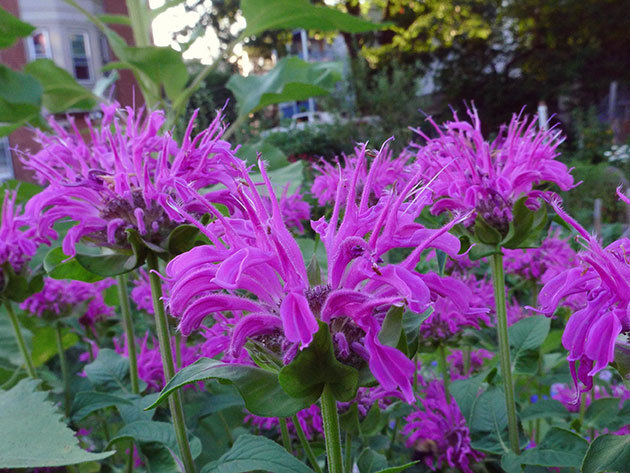
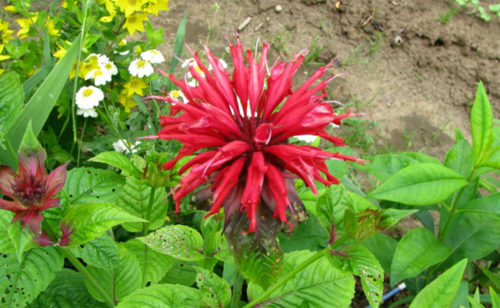
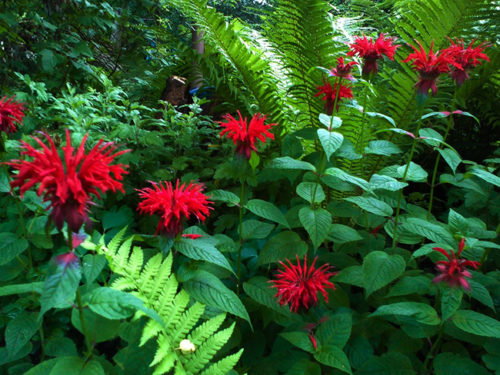
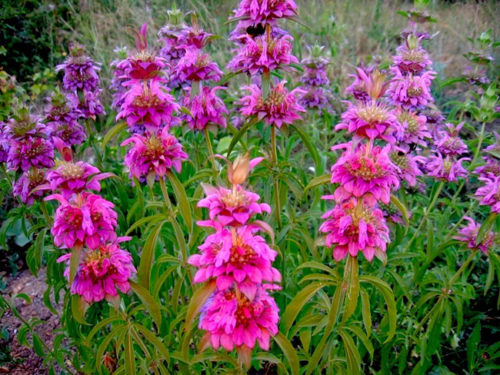
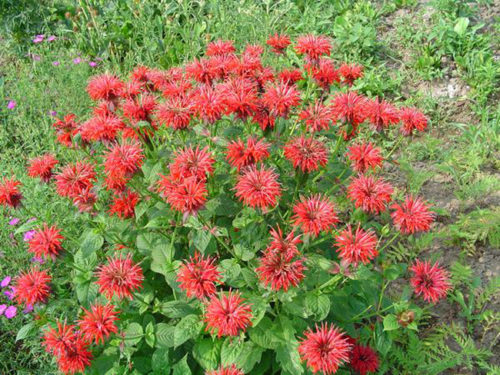
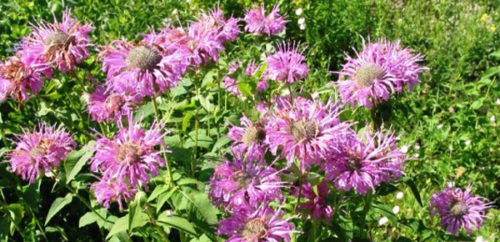
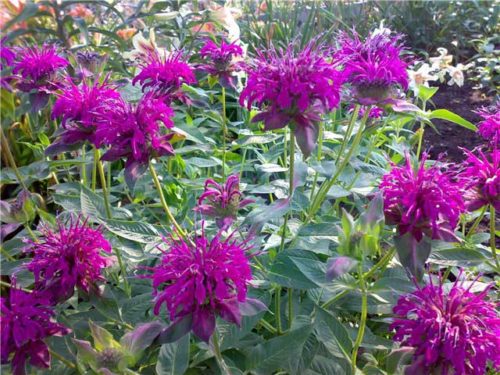
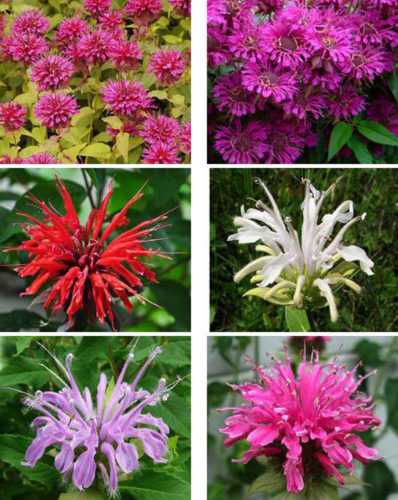
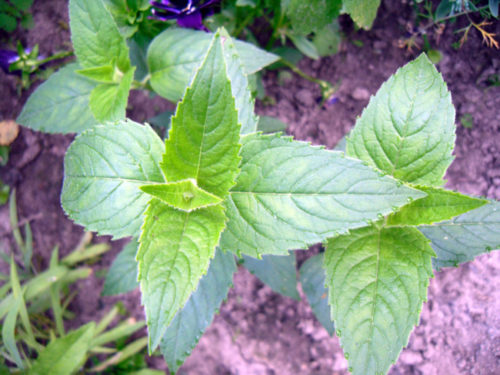
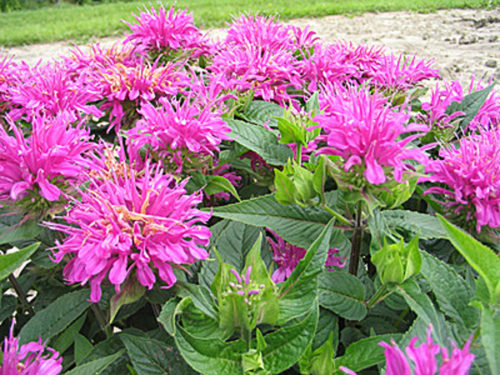
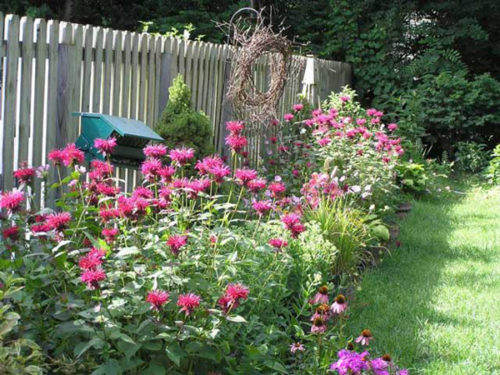
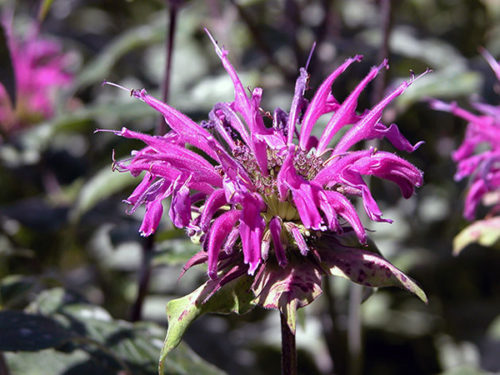
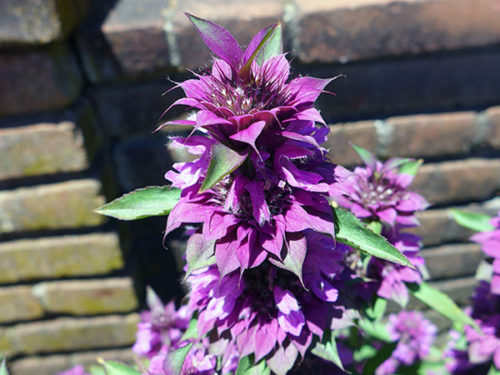
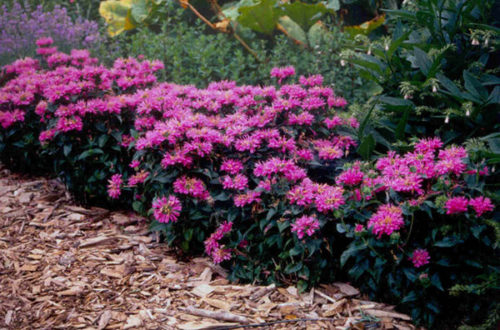
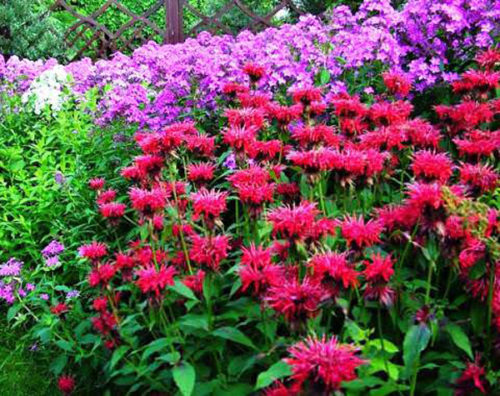
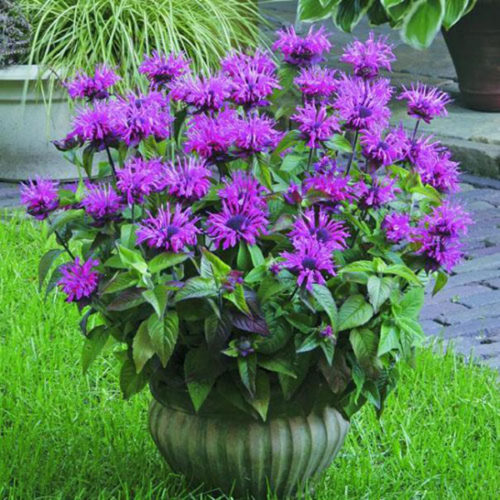












 Start a discussion ...
Start a discussion ...